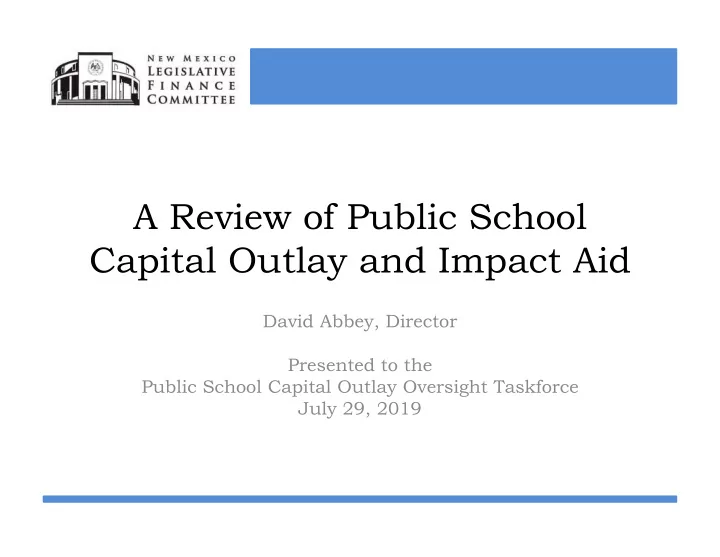

A Review of Public School Capital Outlay and Impact Aid David Abbey, Director Presented to the Public School Capital Outlay Oversight Taskforce July 29, 2019
History of School Operational Funding Equalization • New Mexico was an early adopter of school finance reform – 1969: Student-weighted public school formula created – 1974: State equalization guarantee (SEG) formula created – Goal: equalize financial opportunity for each student appropriate to educational need regardless of location or local economic condition • New Mexico shifted school operational funding from a local wealth base to state support model – 1969: State provides first public school support appropriations – 1981: School mill levy changed from 8.925 to 0.500 2
History of School Operational Funding Equalization With formula reform (1974), New Mexico began crediting 95% • of certain local and federal revenues to equalize program costs – Credits include federal operational Impact Aid payments (formerly PL 874), 0.500 school mill levy, and forest reserve funds Impact Aid payments were intended to assist school districts † impacted by lost tax • revenue or impacted by increased expenditures due to the presence of tax-exempt, federal land (military, tribal, etc.) or enrollment of federally-connected children † Districts in other states typically rely on local property taxes for operational funding In 1999, New Mexico reduced the SEG credit down to 75% • – Dis-equalized SEG but helped Impact Aid districts alleviate cash flow constraints from late federal Impact Aid payments – Represented a shift back to a local wealth base-approach 3
2019 Legislative Session • 2019: Multiple bills were introduced to eliminate the 75% SEG credit for Impact Aid payments – This would effectively provide Impact Aid districts more operational funding per student than other districts Select Districts' FY19 Estimated Program Cost per Student $14,000 $12,000 $10,000 $8,000 $6,000 $4,000 $2,000 $0 Aztec Deming Gadsden Hatch Santa Fe Bernalillo Central Gallup Grants Zuni Non-Impact Aid District Impact Aid District With 75 Percent Credit No Impact Aid Credit 4
2019 Legislative Session FY18 Impact Aid School Districts • Districts seeking elimination Total Operational Facility Condition Budgeted Cash District 1 Impact Aid 2 Index Balance of the 75% Impact Aid credit Alamogordo $845,721 43.1% 8.0% Albuquerque $121,817 35.5% 7.0% Bernalillo $4,317,509 19.3% 13.1% Bloomfield $681,917 39.2% 18.0% – Expressed difficulties with Central Cons. $22,844,050 29.6% 22.6% Clovis $226,515 41.9% 16.0% raising local capital outlay Cuba $1,090,719 15.5% 13.4% Dulce $3,444,487 16.6% 26.5% revenue Española $101,269 33.1% 8.9% Gallup $29,269,348 26.0% 23.3% Grants $3,366,922 29.7% 21.6% – Received the most federal Jemez Mountain $243,188 44.6% 25.8% Jemez Valley $1,060,985 36.2% 17.5% Impact Aid payments Los Alamos $397,160 37.7% 6.9% Los Lunas $223,224 33.1% 8.6% Magdalena $463,725 48.1% 16.1% Maxwell $520 47.7% 3.6% – Operated schools with better Peñasco $29,661 36.4% 6.4% Pojoaque $1,157,449 28.6% 0.0% than average facility conditions Portales $6,638 35.9% 6.6% Raton $13,552 35.8% 7.9% Ruidoso $305,054 37.2% 28.5% – Maintained larger than average Taos $42,373 25.2% 12.2% Tularosa $354,216 36.3% 12.5% cash reserves Zuni $7,308,837 27.8% 10.4% Statewide $77,916,856 32.1% 9.3% 1. Includes locally-chartered charter schools. 2. Excludes Impact Aid for special education, Native American education, or construction. Source: LFC Files 5
2019 Legislative Session • Eliminating the 75% SEG credit would not directly address issues of raising local capital outlay revenue – Approach would dis-equalize operational revenue and disproportionately increase Impact Aid districts’ cash flow – May result in the elimination of other credits (0.500 mill levy and federal forest reserve) and shift more emphasis to local wealth • New Mexico should consider other ways to directly address capital outlay concerns of Impact Aid school districts rather than eliminating the 75% SEG credit 6
Considerations • Allocate capital outlay directly to Impact Aid districts – 2019 Session: $24 million for “above adequacy” construction; $10 million for teacherages (teacher housing) • Develop funding mechanisms for facility spaces eligible, but not previously defined, within the adequacy standards – Over time, PSCOC programs have expanded to include various capital outlay projects: • Facilities Master Plans (2003) • Systems-Based Projects (2017) Standards-Based Projects (2004) Prekindergarten Classrooms (2018) • • • Lease Assistance (2005) • School Security (2018) • Broadband Deficiencies (2014) • Teacherages and Outside-of-Adequacy (2019) – PSFA is currently defining new program funding rules for teacherages 7
Considerations Level the playing field between property-wealthy and property- • poor districts – 2018 Session: Chapter 66 (SB30) will change the calculation of local and state funding matches for capital outlay projects by FY24 • Albuquerque local match: 45% (FY18) → 91% (FY24) • Central local match: 38% (FY18) → 46% (FY24) • Gallup local match: 20% (FY18) → 20% (FY24) • Los Alamos local match: 53% (FY18) → 88% (FY24) • Rio Rancho local match: 33% (FY18) → 73% (FY24) • Zuni local match: 0% (FY18) → 0% (FY24) – Increase the state match guarantee for the SB-9 levy or create a foundation grant program to increase capacity for property-poor districts 8
Considerations • Apply the 75% SEG credit to other uncredited local revenue sources to fully equalize operational funding – Los Alamos Department of Defense operational allocation ($8 million) – Other revenues from renewable energy sources (e.g. IRBs) • Limit all school facility construction to a uniform “ceiling” • Pool all local and state capital outlay revenue together and redistribute funding to all districts through a formula 9
Recommend
More recommend